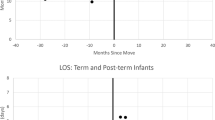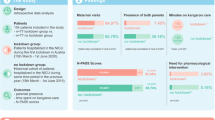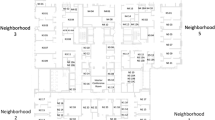Abstract
Objective:
To explore differences in maternal factors, including visitation and holding, among premature infants cared for in single-patient rooms (SPR) compared with open-bay in the neonatal intensive care unit (NICU).
Study Design:
A total of 81 premature infants were assigned to a bed space in either the open-bay area or in a SPR upon NICU admission, based on bed space and staffing availability in each area. Parent visitation and holding were tracked through term equivalent, and parents completed a comprehensive questionnaire at discharge to describe maternal health. Additional maternal and medical factors were collected from the medical record. Differences in outcome variables were investigated using linear regression.
Result:
No significant differences in gestational age at birth, initial medical severity, hours of intubation or other factors that could affect the outcome were observed across room type. Significantly more hours of visitation were observed in the first 2 weeks of life (P=0.02) and in weeks 3 and 4 (P=0.02) among infants in the SPR. More NICU stress was reported by mothers in the SPR after controlling for social support (P=0.04).
Conclusion:
Increased parent visitation is an important benefit of the SPR, however, mothers with infants in the SPR reported more stress.
This is a preview of subscription content, access via your institution
Access options
Subscribe to this journal
Receive 12 print issues and online access
$259.00 per year
only $21.58 per issue
Buy this article
- Purchase on Springer Link
- Instant access to full article PDF
Prices may be subject to local taxes which are calculated during checkout
Similar content being viewed by others
References
Miles MS, Funk SG, Carlson J . Parental Stressor Scale: neonatal intensive care unit. Nurs Res 1993; 42 (3): 148–152.
Jamsa K., Jamsa T. . Technology in neonatal intensive care–a study on parents’ experiences. Technol Health Care 1998; 6 (4): 225–230.
Howland LC, Pickler RH, McCain NL, Glaser D, Lewis M . Exploring biobehavioral outcomes in mothers of preterm infants. MCN Am J Matern Child Nurs 2011; 36 (2): 91–97.
Affleck G, Tennen H . The effect of newborn intensive care on parents’ psychological well-being. Child Health Care 1991; 20: 6–14.
Ortenstrand A, Westrup B, Broström EB, Sarman I, Akerström S, Brune T et al. The Stockholm Neonatal Family Centered Care Study: effects on length of stay and infant morbidity. Pediatrics 2010; 125 (2): e278–e85.
Stevens DC, Helseth CC, Khan MA, Munson DP, Smith TJ . Neonatal intensive care nursery staff perceive enhanced workplace quality with the single-family room design. J Perinatol 2010; 30 (5): 352–358.
Domanico R, Davis DK, Coleman F, Davis BO Jr . Documenting the NICU design dilemma: parent and staff perceptions of open ward versus single family room units. J Perinatol 2010; 30 (5): 343–351.
Domanico R, Davis DK, Coleman F, Davis BO Jr . Documenting the NICU design dilemma: comparative patient progress in open ward and single family room units. J Perinatol 2011; 31 (4): 281–288.
Erdeve O, Arsan S, Canpolat FE, Ertem IO, Karagol BS, Atasay B et al. Does individual room implemented family-centered care contribute to mother-infant interaction in preterm deliveries necessitating neonatal intensive care unit hospitalization? Am J Perinatol 2009; 26 (2): 159–164.
Newnham CA, Inder TE, Milgrom J . Measuring preterm cumulative stressors within the NICU: The Neontal Infant Stressor Scale. Early Human Dev 2009; 85 (9): 549–555.
Speilberger C . State-Trait Anxiety Inventory for Adults. Mind Garden: Menlo Park, 2005–2008.
Cox JL, Holden JM, Sagovsky R . Detection of postnatal depression:development of the 10-item Edinburgh Postnatal Depression Scale. Br J Psychiatry 1987; 150: 782–786.
Endler N, Parker JD . Coping Inventory for Stressful Situations (CISS): Manual. Toronto, Canada: Multi-Health Systems, 1990.
Miles MS, Funk SG, Carlson J . Parental Stressor Scale: neonatal intensive care unit. Nurs Res 1993; 42 (3): 148–152.
Abidin R . Parenting Stress Index, Third Edition. Charlottesville: Pediatric Psychology Press, 1990.
Sarason IG, Levine HM, Basham RB, Sarason BR . Assessing social support: The Social Support Questionnaire. J Pers Soc Psychol 1983; 44 (1): 127–139.
Poehlmann J, Schwichtenberg AJ, Bolt D, Dilworth-Bart J . Predictors of depressive symptom trajectories in mothers of preterm or low birth weight infants. J Fam Psychol 2009; 23 (5): 690–704.
Beck CT . Predictors of postpartum depression: an update. Nurs Res 2001; 50 (5): 275–285.
Brown N, Doyle LW, Bear MJ, Inder TE . Alterations in neurobehavior at term reflect differing perinatal exposures in very preterm infants. Pediatrics 2006; 118 (6): 2461–2471.
Franck L, Spencer C . Parent visiting and participation in infant caregiving activities in a neonatal unit. Birth 2003; 30 (1): 31–35.
Acknowledgements
This project was supported by the National Institute of Health (ROI HD 057098) and the Doris Duke Foundation.
Author information
Authors and Affiliations
Corresponding author
Ethics declarations
Competing interests
The authors declare no conflict of interest.
Rights and permissions
About this article
Cite this article
Pineda, R., Stransky, K., Rogers, C. et al. The single-patient room in the NICU: maternal and family effects. J Perinatol 32, 545–551 (2012). https://doi.org/10.1038/jp.2011.144
Received:
Revised:
Accepted:
Published:
Issue Date:
DOI: https://doi.org/10.1038/jp.2011.144
Keywords
This article is cited by
-
A quality improvement initiative to reduce the time to initial maternal visit in the neonatal intensive care unit
Journal of Perinatology (2024)
-
Effects of single family room architecture on parent–infant closeness and family centered care in neonatal environments—a single-center pre–post study
Journal of Perinatology (2021)
-
Randomized clinical trial investigating the effect of consistent, developmentally-appropriate, and evidence-based multisensory exposures in the NICU
Journal of Perinatology (2021)
-
Enhancing the NICU language environment with a neonatal Cuddler program
Journal of Perinatology (2021)
-
A comparative study of mothers of infants hospitalized in an open ward neonatal intensive care unit and a combined pod and single-family room design
BMC Pediatrics (2020)



